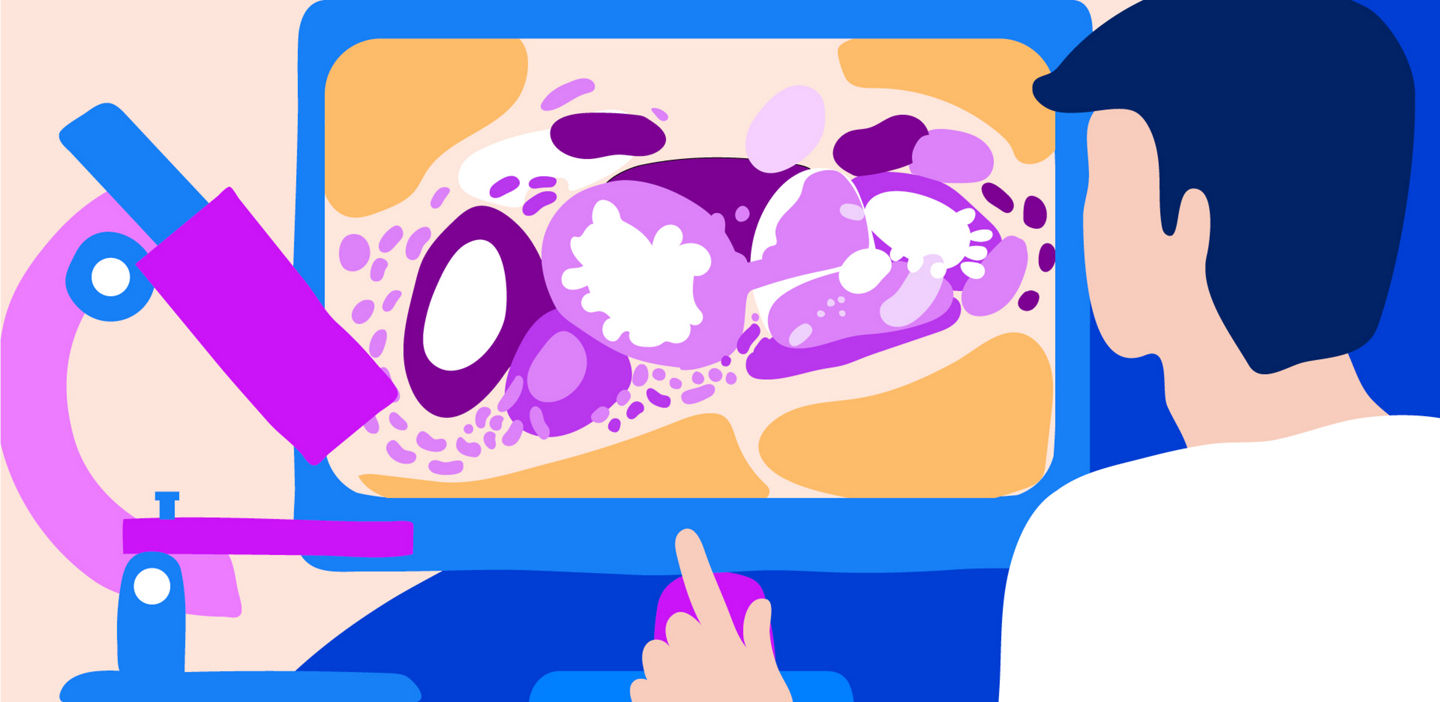Contributing lab leader: Michael Rivers, Marta Canamero, Markus Herrmann and Christoph Guetter
The digital transformation of pathology: How computational pathology can impact patient care
In today's rapidly advancing technological landscape, pathology is undergoing a profound transformation through the integration of digital computation technology. Computation pathology, encompassing digital imaging, artificial intelligence (AI), and data analytics, promises to revolutionize the way diseases are identified, diagnosed, and treated. This convergence of traditional medical expertise and cutting-edge technology opens new horizons for more accurate diagnoses, personalized treatment plans, and improved patient outcomes.
So, how will these new technologies, including AI, impact the field of pathology and patient care in the long run? This was the focus of the latest LabLeaders webinar. Michael Rivers, Vice President Lifecycle Leader for Digital Pathology at Roche was joined by Dr. Marta Canamero, Medical Affairs Oncology Lead at Roche, Dr. Markus Herrmann, Senior Medical Director for Personalized Healthcare at Roche, and Dr. Christoph Guetter, Director of Algorithm Development at Roche, as they took a deep dive into the current state of digital pathology, the role of AI, and the evolving responsibilities of pathologists in the age of AI.
- The integration of digital computation technology, including AI and data analytics, is revolutionizing pathology, promising more accurate diagnoses and personalized treatment plans.
- The adoption of digital pathology and AI in clinical practice is on the rise, with the potential to significantly improve accuracy and efficiency in pathology.
- AI is expected to enhance the role of pathologists, focusing on interpreting results and making clinical decisions, ultimately leading to more patient-centered care and advancing the field of pathology.
Want to hear even more about the digital transformation of pathology? Click the button to register and watch our on-demand webinar now!
While the adoption of digital pathology is on the rise, it is not yet widespread in clinical practice. A low percentage of laboratories have fully embraced digital pathology, but the pandemic has accelerated its adoption. Laboratories are gradually implementing digital solutions and experimenting with digital pathology, paving the way for future integration of promising AI image analysis algorithms.
The integration of AI into pathology is in its early stages. Many labs incorporating digital solutions are also exploring AI applications. Although few AI solutions are FDA-cleared with an IVD label, this is expected to change rapidly in the coming months and years. AI offers significant potential for improving accuracy, efficiency, and clinical decision-making in pathology.
Several challenges hinder the widespread use of AI in pathology, including pre-analytic and morphological variability. AI models require substantial computational resources, and ensuring explainability and transparency in AI decisions is crucial. More labs will move towards full automation as AI algorithms achieve higher accuracy levels, starting with filtering and focusing on relevant areas of prediction.
Addressing these challenges requires rigorous quality control and validation processes. Building robust datasets, including training, tuning, and analytical verification sets, is essential. This meticulous approach ensures that AI algorithms can handle real-world variability and produce reliable results. Validation is critical to gaining trust in AI's role in pathology.
Panelists discussed areas where AI will have the most significant impact. Quantifying complex measurements, such as identifying patterns and quantifying signals, is an area where AI can outperform human pathologists. AI can also assist in processing large, intricate datasets beyond human capacity, such as volumetric imaging. Additionally, AI can infer valuable insights from standard H&E slides, potentially reducing the need for multiple specialized tests.
Contrary to concerns about job displacement, pathologists' roles will evolve and become more focused on integrating data and clinical information. With AI handling repetitive tasks, pathologists will be able to concentrate on interpreting results and making crucial clinical decisions. This shift will lead to a more patient-centered approach and will support the move towards precision medicine.
It will be crucial that everyone in this space works together in order to develop tools that meet specific clinical needs, the panelists said, highlighting that companies should bring together their own in-house algorithms with developments from within the broader AI community.
Rather than replacing pathologists, AI is poised to enhance their capabilities, ultimately improving patient care and advancing the field of pathology. As the healthcare industry continues to embrace these transformative technologies, the future of pathology looks brighter than ever. The synergy of digital computation and pathology looks set to revolutionize healthcare, providing more precise diagnoses and personalized treatments for patients.
Want to hear even more about the digital transformation of pathology? Then click here to register and watch our on demand webinar now!

